D.H. Lawrence's 99 Days in Australia
ART, MUSIC & FILM
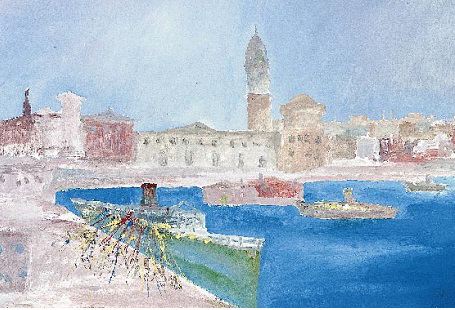 |
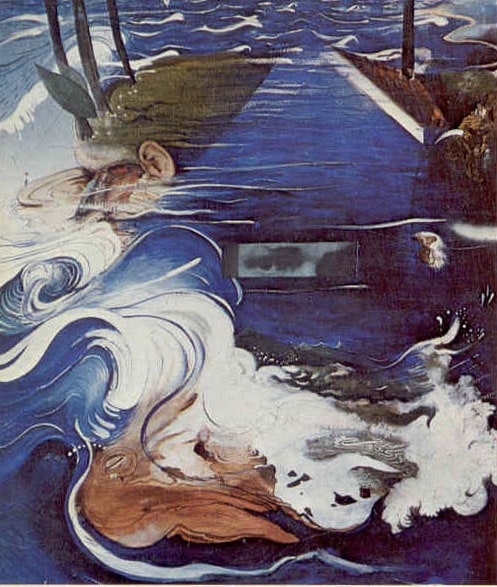 |
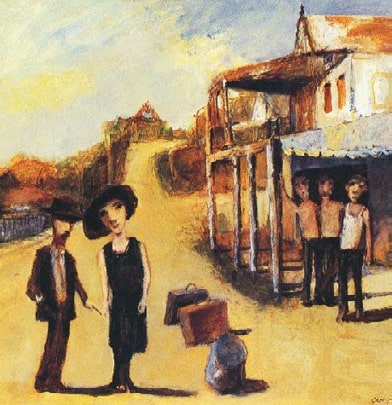 |
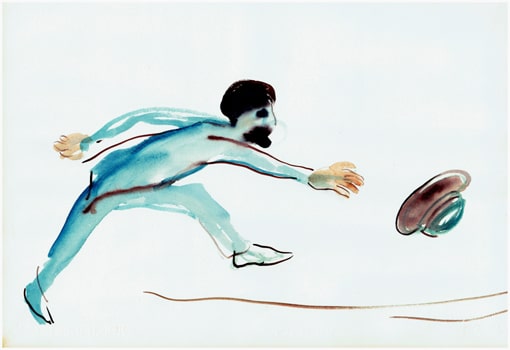 |
Nolan |
Whiteley |
Shead |
Delprat |
LAWRENCE'S BRIEF VISIT TO AUSTRALIA HAS INSPIRED MANY LOCAL ARTISTS"Lawrence & Australian Art"
|
|||||||||||
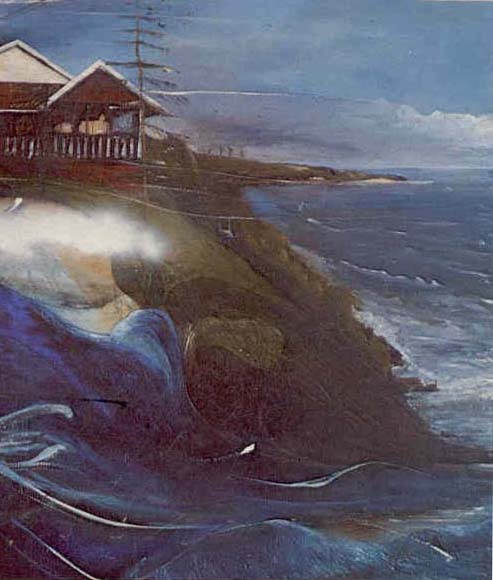 |
 |
Diptych depicting "Wyewurk" by Garry Shead (left) & by Brett Whiteley (right) |
|
LAWRENCE'S VISIT to Australia in 1922, and the novel he wrote there, Kangaroo, have inspired many leading Australian artists and creative minds. The novel has acted as a catalyst for their talents, producing important works. Kangaroo is the common thread that winds through their work, and links them.
Australia's leading composer, the late Peter Sculthorpe, sensed an affinity with Lawrence in their mutual pantheism and love of landscape. He first wrote a song cycle, "Sun", based on three of Lawrence's poems, and later developed this into a major work, "Irkanda IV". The lines in Lawrence's poem
Lawrence continued to inspire Sculthorpe, and in 1963 he composed a work in five movements, "The Fifth Continent". The third movement was revised in 1976 to become a shorter work, "Small Town", based on Thirroul, which he felt epitomised all Australian country towns. The statue of the returned Digger, which used to stand outside the School of Arts at Thirroul, and which Lawrence mentions in Kangaroo, led Sculthorpe to introduce an oboe solo, mingled with the bugle sound of the "Last Post", giving a chilling, nostalgic undercurrent to the lyrical piece:
A sun will rise in me.
I shall slowly resurrect,
Already the whiteness of false dawn is on my inner ocean.
This deeply affected Sculthorpe, who said: . "It was in this section that I finally managed to recompose my setting of the DH Lawrence poem ‘Sun in Me'. The melisma of the solo violin is a reflection of the poem. Thus, in the final bars, there is a high white C. Lawrence in his poem relates sun and atom to God and atom. The high white C, which must be the whitest note of all, represents the word ‘God'."
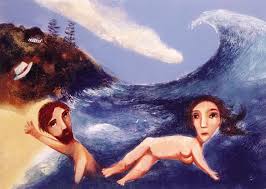 |
Somers & Harriett bathing - by Garry Shead |
Artist Garry Shead, too, responded to the military undercurrents in Kangaroo with his celebrated Kangaroo series of paintings and etchings. Shead also uses the image of the Diggers' memorial. Always looming in his pictures of Lawrence and Frieda at "Wyewurk" is the mysterious, sometimes menacing, sometimes slightly comical, figure of a kangaroo. In 2011 Sculthorpe and Shead collaborated on a DVD production using the Kangaroo series and the music of "Small Town".
Shead also collaborated with another great Australian artist who was strongly attached to, perhaps haunted by, Lawrence and Thirroul – the late Brett Whiteley. In 1975 the two painters decided to go down to Thirroul and paint a diptych. (see above).
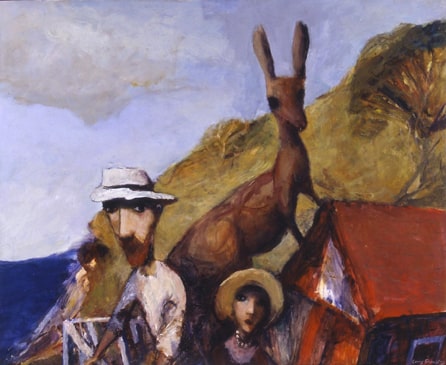 |
Somers & Harriett at Wyewurk, with the omni-present Kanagroo looming over them - by Garry Shead |
"Brett suggested one day that we try to soak up the Lawrence ambience there," Garry recalled. "Brett particularly empathised with Lawrence and his stormy relationship in "Wyewurk" with Frieda. There was more than a hint of this in the picture." The two artists wanted to paint from the veranda of "Wyewurk", so Whiteley, with his two silky terriers in train, approached the door of the bungalow, aware that the tenant at that time, a dentist, did not welcome visitors. "As we were talking to the occupant, who was very gruff, one of Brett's dogs ran inside the house. Suddenly we had an excuse to go inside to find the dog," Shead remembered. As they tried to coax the dog out of the house, the pair caught a glimpse of the jarrah table where Lawrence wrote Kangaroo. Next they approached the owner of the house next door, who allowed them to set up their easels on her veranda, and they began work. "Brett had cheated a little. He'd already half done his work before coming down, and then he painted partly on my side of the canvas," Shead said. Both halves of the diptych depict a stormy scene, with angry waves lashing the shore. Shead's half shows "Wyewurk" teetering on its cliff above a raging sea. The colours are deep purples and blues, contrasting with the olive green of the foliage. Whiteley's trademark white-wisps wash into Shead's scene. Whiteley's half echoes the same deep blues, purple and green, but his painting basically depicts a ramp disappearing into the angry ocean – "a ramp leading to oblivion", as Brett described it to Shead. Lawrence's face floats in the foreground.
Having completed the diptych, the two artists decided to invite Australia's leading author, Patrick White, to its unveiling at a Sydney gallery. Brett, who knew White well (and later painted what White regarded as the best portrait of him), was aware of White's obsession with Lawrence, who was, in White's opinion, one of the three great writers of the 20th century. In 1939 White made a personal pilgrimage to Taos, to pay homage to Lawrence. Dorothy Brett took him to meet Frieda, whom he found "witty and amusing".
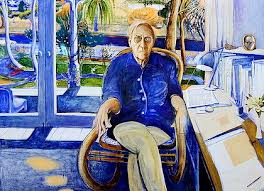 |
Patrick White - by Brett Whiteley |
However, White's reaction to the diptych at its gallery "premiere" was not what Shead and Whiteley had expected. "Brett was a person given to the dramatic, so he made something of an event of the unveiling – or rather the unlocking – of the diptych," Shead recalled. "The work consisted of a book-like construction, in imitation of the traditional religious diptyches of medieval times. As White and the rest of the opening-night audience gathered before the closed diptych, Brett unlocked it and swung open its leaves, to reveal the full work in all its magnificence. I think Brett was a trifle disappointed with White's reaction to this ceremony. It may have been White's aversion to public displays of emotion, but he did not go overboard about the work, though in fact it was dedicated to him." Brett Whiteley made regular visits to Thirroul. His last visit was in 1992, when he died there from a drug-overdose, alone, in a local motel room. A life, and a talent, that Australia could ill-afford to lose. He was only 53.
However, this was not to be the only diptych involving Lawrence and Kangaroo that was to trouble Patrick White. In October 1982 Sidney Nolan, then perhaps Australia's most famous living artist, painted a series of eight works which he called his "Kangaroo series". These have only been exhibited once, briefly, in a gallery in Perth, Western Australia, in 1983. The series included a diptych. The events which led to the creation of this diptych are harrowing, and involve a suicide, a broken friendship, a trust betrayed, a wounded reaction, and a brutal response. Before that, Nolan and White had been, to all intents, the best of friends. Nancy Underhill, who was writing her biography of Nolan at the time when I contacted her, told me: "Patrick White first saw Nolan's works in 1949 at the Macquarie Gallery in Sydney, and was much taken by them. White wrote to Nolan asking him to do the cover for Voss. Yet White and Nolan did not actually meet until 1956 in, of all places, Fort Lauderdale, Florida. The Nolans – Sidney, Cynthia and her young daughter, Jinx – were on vacation in America, while White and his lover Manoly Lascaris were visiting Manoly's sister Anna in her "claustrophobic" house set "in a mangrove swamp, on a road leading from nowhere to nowhere, in other words, the rest of Florida". Subsequently, for a number of days, White and the Nolans toured around Florida's mangrove swamps, gas stations and hamburger joints, forging a "meeting of minds" that was to last until 1981.
White was particularly taken with Cynthia, whom he categorised as "steel" to Nolan's "elastic". Whenever Nolan and White were together in the one country, they made a point of seeing one another, and Nolan went on to illustrate the covers of a number of Patrick White's novels. Such close friends did they become that when White was awarded the Nobel Prize for Literature in 1973, he asked Nolan (who was living in England) to accept the Prize on his behalf, preferring not to make the long trip from Australia to Stockholm himself.
During this time, White kept up a regular correspondence with Cynthia, describing her as "one of the women I have admired most" – a particular compliment, coming from Patrick White. (Nolan himself was not a good letter-writer, so communication between the Nolans and White was via Cynthia.) Then, in London in 1976, Cynthia committed suicide. White was deeply upset. Just how deep did not become apparent until five years later, when White's autobiography, Flaws in the Glass, was published. The book contained a personal attack on Nolan, accusing him of "treachery" for re-marrying too soon after Cynthia's suicide.. (Continued over page).